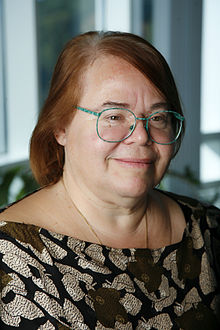Eve Marder
Eve Esther Marder (born May 30, 1948 in New York City ) is an American neurobiologist.
Life
Marder graduated from Brandeis University with a bachelor's degree in 1969 and received a PhD in biology from the University of California, San Diego , in 1974 . As a post-doctoral student , she was at the University of Oregon in 1975 and from 1976 to 1978 at the École normal supérieure in Paris. Then she was a professor at Brandeis University, since 1990 with a full professorship. In 1980 she received a research grant from the Alfred P. Sloan Foundation ( Sloan Research Fellowship ).
She is married to Arthur Wingfield.
plant
Marder studies the mechanisms by which neurotransmitters and neuropeptides modify small nerve circuits and the numerical dynamics of small networks. At the beginning of her career she studied small nerve circuits using the example of the stomatogastric ganglion systems (STG) of lobsters and other crustaceans, which control the digestive system, consist of only 30 large neurons and generate a rhythmic pattern. She was able to show that their behavior depended on various substances that modulate the neurons and was therefore not fixed (they showed neuroplasticity ). These findings were very influential at the time and caused a change in neurobiology. She later also pioneered the numerical simulation of realistic small neural networks. Together with others, she developed a computer-controlled experimental tool with real neuron cells (Dynamic Clamp), which was widely used.
Recently, she has been working on the stabilization mechanisms of constantly reconfiguring neural networks, which are important for maintaining the biological function of these networks.
From 1984 to 1990 she was editor of the Journal of Neurophysiology. In 2007 she was President of the Society for Neuroscience.
Honors and memberships
In 2013 she received the Gruber Prize for Neuroscience . She is a Fellow of the American Association for the Advancement of Science , the National Academy of Sciences (2007), and the American Academy of Arts and Sciences (2001). In 1995 she received a McKnight Foundation Award, in 1987 the Javits Award in Neurosciences, the MERIT Award from the National Institute of Mental Health (NIMH), in 2005 the Ralph W. Gerard Prize and the Miriam Salpeter Lifetime Achievement Award of Women in Neurosciences. For 2016 she was awarded the Kavli Prize , for 2019 the NAS Award in the Neurosciences .
Fonts
- with RM Harris-Warrick Modulation of Neural Networks for Behavior , Annual Review of Neuroscience, Volume 14, 1991, pp. 39-57
- with RM Harris-Warrick, Allen Selverston, M. Moulin (editors): Dynamic Biological Networks: The Stomatogastric Nervous System , Cambridge: MIT Press 1992
- with TB Kepler, LF Abbott Reduction of conductance-based neuron models , Biological Cybernetics, 66, 1992, 381-387
- with IR Epstein: Multiple modes of a conditional neural oscillator , Biological Cybernetics, 63, 1990, 25–34
Web links
Individual evidence
- ↑ Life data according to American Men and Women of Science , Thomson Gale 2004
- ↑ Allen Selverston STG , Scholarpedia
- ^ AA Sharp, LF Abbott, E. Marder Artificial Electrical Synapses in Oscillatory Networks , J Neurophysiol. 67, 1992, 1691-1694
- ^ AA Sharp, MB O'Neil, LF Abbott, E. Marder Dynamic Clamp: Computer-Generated Conductances in Real Neurons , J Neurophysiol. 69, 1993, 992-995
- ^ Sharp, O'Neil, Abbott, Marder The dynamic clamp: artificial conductances in biological neurons , Trends Neuroscience, 16, 1993, 389-394
- ^ A. Prinz, LF Abbott, E. Marder The dynamic clamp comes of age , Trends Neurosci. 27, 2004, 218-224
- ↑ J.-M. Goillard, Marder Dynamic clamp analyzes of cardiac, endocrine, and neural function , Physiology, 21, 2006, 197-207. See also Astrid Prinz, Robert Cudmore Dynamic Clamp , Scholarpedia
- ^ Book of members. Retrieved July 26, 2016 .
| personal data | |
|---|---|
| SURNAME | Marten, Eve |
| ALTERNATIVE NAMES | Marder, Eve Esther (full name) |
| BRIEF DESCRIPTION | American neurobiologist |
| DATE OF BIRTH | May 30, 1948 |
| PLACE OF BIRTH | New York City |
